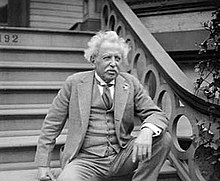| Frank Lambert | |
|---|---|
 Frank Lambert in 1926 Frank Lambert in 1926 | |
| Born | Francois Lambert (1851-06-13)June 13, 1851 Lyon, France |
| Died | 1937 (aged 85–86) |
| Occupation | Inventor |
| Signature | |
Francois Lambert (13 June 1851 – 1937) was a French American inventor. Lambert is perhaps best known today for making the oldest sound recording reproducible on its own device (1878) on his own version of the phonograph. Lambert also invented a typewriter on which the keyboard consists of one single piece.
Work
Lambert was born in Lyon, France; he relocated to the United States in 1876 and became a U.S. citizen in 1893.
Twelve years after arriving in the U.S., Lambert, along with a friend John Thomson, founded The Thomson Water Meter Co. to manufacture their design of a water meter.
In 1878 or 1879 he built his own version of Edison's sound recording device, the Phonograph, and recorded himself calling out the hours for an Experimental Talking Clock he was developing for the Ansonia Clock Company in Connecticut. However, the attempts to make a commercially viable "phonograph clock" proved unsuccessful.
After being restored by Aaron Cramer, Lambert's talking clock is currently at the National Watch and Clock Museum in Columbia, PA, and is listed in The Guinness Book of World Records and in The Encyclopedia of Recorded Sound as the world's oldest playable recording. Until 2008 it was considered to be the oldest surviving sound recording but a phonautogram of Au Clair de la Lune by Édouard-Léon Scott de Martinville from 1860 has been found to pre-date it. However, Lambert's recording is still the oldest which can be played with its own original device, unlike the phonautogram which was played by optically scanning it and using a computer to process the scan into a digital audio file.

Lambert completed his main invention, a typewriter on which the keyboard consists of one single piece. He sold it to the Gramophone Co. Ltd., for which he received US$20,000. Lambert's water meter company was sold outright to the Neptune Water Meter Co. and Lambert received $800,000.
During his career he registered over 30 patents for, among other things, typewriters, water meters, a voting machine, and a double-decked car.
References
- "Frank Lambert - Talking Clock". University of Pennsylvania. Retrieved 26 June 2017.
- ^ Goodale, Greg (2011). Sonic Persuasion: Reading Sound in the Recorded Age. University of Illinois Press. p. 135. ISBN 9780252093203.
- ^ Howard, Martin. "Antique Typewriters". Archived from the original on 18 January 2017. Retrieved 25 June 2017.
- ^ Robert, Paul (2007). The Typewriter Sketchbook. Lulu Enterprises Incorporated. ISBN 9781847991522.
- "Letters Patent number 741251" (PDF). 28 April 1902. Retrieved 26 June 2017.
- ^ "Lambert Water Meter". Smithsonian, National Museum of American History. Retrieved 26 June 2017.
- Hofmann, Frank; Ferstler, Howard (2005). Encyclopedia of Recorded Sound (2nd ed.). Routledge. p. 767. ISBN 0415971209.
- ^ Goodall, Howard (2011). Big Bangs. Random House. p. 184. ISBN 9781446484548.
- ^ Schoenherr, Steven (2004). "Early Talking Machines After Edison". Audio Engineering Society. Retrieved 26 June 2017.
- "Ansonia Clock Company History". Antique Ansonia Clocks. 2010. Archived from the original on 12 August 2015. Retrieved 26 June 2017.
- Liebert, Peter (2006). "A Memorial Tribute to Aaron Cramer". Retrieved 26 June 2017.
- Rosen, Jody (27 March 2008). "Researchers Play Tune Recorded Before Edison". New York Times. Retrieved 26 June 2017.
- "Lambert Patents". Retrieved 26 June 2017.